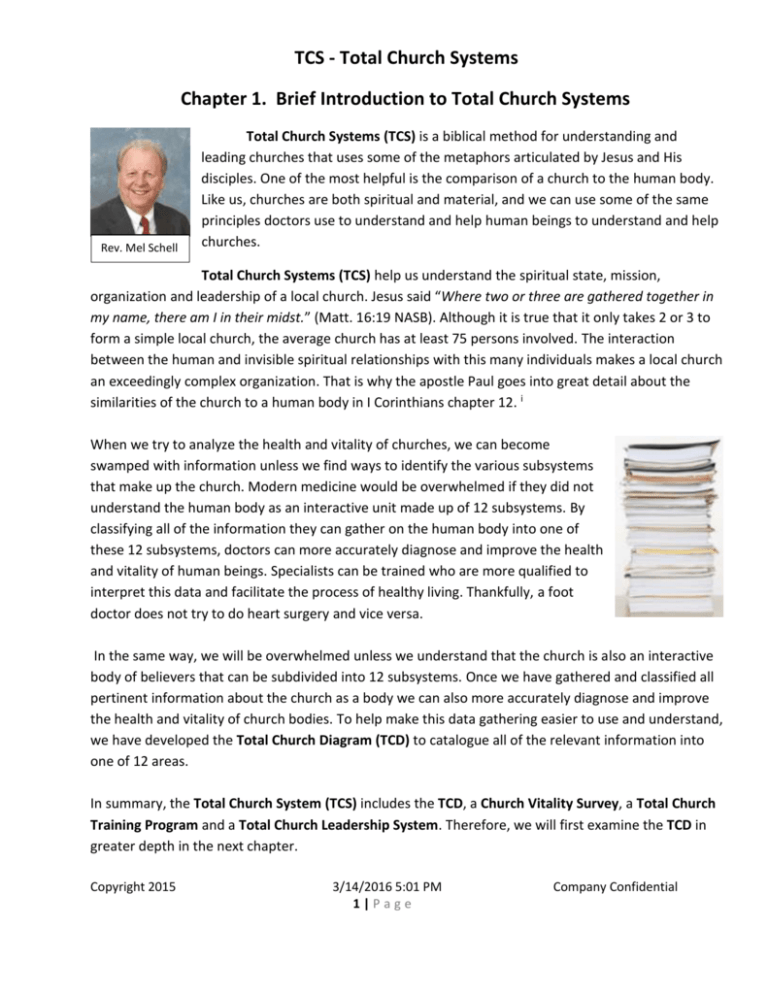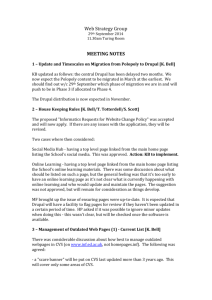- Growth Ministries International
advertisement

TCS - Total Church Systems Chapter 1. Brief Introduction to Total Church Systems Rev. Mel Schell Total Church Systems (TCS) is a biblical method for understanding and leading churches that uses some of the metaphors articulated by Jesus and His disciples. One of the most helpful is the comparison of a church to the human body. Like us, churches are both spiritual and material, and we can use some of the same principles doctors use to understand and help human beings to understand and help churches. Total Church Systems (TCS) help us understand the spiritual state, mission, organization and leadership of a local church. Jesus said “Where two or three are gathered together in my name, there am I in their midst.” (Matt. 16:19 NASB). Although it is true that it only takes 2 or 3 to form a simple local church, the average church has at least 75 persons involved. The interaction between the human and invisible spiritual relationships with this many individuals makes a local church an exceedingly complex organization. That is why the apostle Paul goes into great detail about the similarities of the church to a human body in I Corinthians chapter 12. i When we try to analyze the health and vitality of churches, we can become swamped with information unless we find ways to identify the various subsystems that make up the church. Modern medicine would be overwhelmed if they did not understand the human body as an interactive unit made up of 12 subsystems. By classifying all of the information they can gather on the human body into one of these 12 subsystems, doctors can more accurately diagnose and improve the health and vitality of human beings. Specialists can be trained who are more qualified to interpret this data and facilitate the process of healthy living. Thankfully, a foot doctor does not try to do heart surgery and vice versa. In the same way, we will be overwhelmed unless we understand that the church is also an interactive body of believers that can be subdivided into 12 subsystems. Once we have gathered and classified all pertinent information about the church as a body we can also more accurately diagnose and improve the health and vitality of church bodies. To help make this data gathering easier to use and understand, we have developed the Total Church Diagram (TCD) to catalogue all of the relevant information into one of 12 areas. In summary, the Total Church System (TCS) includes the TCD, a Church Vitality Survey, a Total Church Training Program and a Total Church Leadership System. Therefore, we will first examine the TCD in greater depth in the next chapter. Copyright 2015 3/14/2016 5:01 PM 1|Page Company Confidential TCS - Total Church Systems Chapter 2 - The 12 Areas of the Total Church Diagram (TCD) 1. These first 3 Areas contain information that affects every person in the church: Figure 2 -1: A Diagram of the 3 Common Areas of the Local Church Area 1 - Input: Contains information about all the relevant exterior influences that affect the entire church. Includes God, culture of the people and community, government influence, beliefs and practices of the participants, policies and procedures of parent denominations, educational institutions, spiritual beliefs and evil spiritual forces. Copyright 2015 3/14/2016 5:01 PM 2|Page Company Confidential TCS - Total Church Systems Area 2 – Participants: Contains information about all known participants in the local church. These may be members, regular attendees, children of members, visitors and staff. It DOES NOT represent a physical church building! Area 3 - Output: Contains information about relevant effects or outputs that are produced by the total church. The Output from the church should be very similar to the Input (Area 1). 2. The next 4 areas contain information that is relevant to the major ministries of the church: Figure 2 – 2: Areas 4 – 7 Added to the Total Church Diagram Copyright 2015 3/14/2016 5:01 PM 3|Page Company Confidential TCS - Total Church Systems Area 4 - Conversion Ministries: Contains information relevant to evangelizing unconverted persons who are not part of the local church. This includes contacting them and influencing them to become followers of the Lord Jesus Christ and active members of your church or another biblical church. Area 5 - Transfer Ministries: Contains information relevant to contacting Christians who not attending a local church and influencing them to become followers of the Lord Jesus Christ in a local church. Area 6 - Optimal Growth Ministries: Contains information relevant to the optimal spiritual development of knowledgeable Christians who are members or participants in a local church. Area 7 – Renewal/Recapture Growth Ministries: Contains information relevant to renewing or evangelizing members or participants of your church. This includes disgruntled or lapsed members of your church along with the children and other family members of active Christians who attend a local church. 3. The final 5 areas have to do with the various groups that are found in almost all local churches. Most of the Members and Participants shown in Area 2 are involved in one of more of these groups. They may have different names and agendas but they each provide an essential ingredient that helps the church function as a spiritual body. Area 8 – Celebration Groups: (CG) – The primary function is to create an atmosphere of Celebration through worship and praise to God. Although there is no upper size limit they work most effectively with at least 75 persons. This includes the primary worship services of a church along with other special celebration events the church may conduct or in which they may participate. Evangelistic services may also be part of Area 8. Area 9 – Fellowship Groups (FG): The primary function is to provide an atmosphere of fellowship for the church. They work best with between 15 to 250 persons. They can have many different agendas, including large Sunday School classes, Bible studies, adult fellowship groups, choirs, youth groups, sports activities and various social events. Area 10 – Kinship Groups (KG): The primary function is to provide an atmosphere of kinship or family to the church. They can range in size from 4 to 14 persons. They can also have many different agendas, including prayer groups, home Bible study groups, small Sunday School classes, adult project groups, choirs, youth groups, sports and various social events. Area 11 – Discipleship Groups (DG): The primary function of this group is to provide a more personal relationship between the members of the church. The ideal size is between 2 to 3 persons. The agenda for these groups includes counseling, training, Bible study, coaching and mentoring by experienced leaders. Copyright 2015 3/14/2016 5:01 PM 4|Page Company Confidential TCS - Total Church Systems Area 12 – Leadership Groups (LG): The primary function of this group is to provide the leadership required for any church to exist. This group is comprised of the ministers, paid staff and volunteers who lead or participate in the leadership groups and who give guidance to all of the other groups of the church. These may include such things as boards of elders, deacons, committees and administrative boards. Figure 2- 3: Areas 2, 8 – 12 Shown Separately from the Other Areas Area 12 is shown by a series of dashed lines surrounding all of the other groupings, including Area 2 – Members/Participants. Note also that the Hexagon which was first identified as Area 2 DOES NOT Copyright 2015 3/14/2016 5:01 PM 5|Page Company Confidential TCS - Total Church Systems represent a physical building. Rather it represents all of the people who participate in any local church, whether they are involved as individuals or as members of a group. With this introduction, we will now show the relationship between all 12 Areas using the Total Church Diagram (TCD). Figure 2 – 4: The Total Church Diagram (TCD) Copyright 2015 3/14/2016 5:01 PM 6|Page Company Confidential TCS - Total Church Systems Figure 4 combines all 12 areas of the Total Church Diagram. Once we have identified all 12 Areas of the church and showed the relationship these Areas have to one another, we can demonstrate how the Church Vitality Survey (CVS) can be used to gather significant information for each of these Areas. Every question on the Survey applies to one or more Areas of the Total Church Diagram. The CVS covers Areas 2, 4, 5, 6, 7 and 12 in some depth while Areas 8, 9, 10 and 11 are lightly addressed. We have one question each for Areas 1 and 3. In addition to the CVS, we can also use research, existing church reports, data gathering forms, observations and interviews to gather more complete data on the entire TCD. The CVS is are most valuable source of information because it is gathered directly from the church members and constituents. Therefore, we will take a closer look at how the Survey can be used to gather an essential base line of information about the church that leaders can then use to improve their ministry for the Lord Jesus Christ. Copyright 2015 3/14/2016 5:01 PM 7|Page Company Confidential TCS - Total Church Systems Chapter 3 The Relationship of the Total Church Diagram (TCD) and the Church Vitality Survey (CVS) As we noted in the prior chapter, every question on the Church Vitality Survey (CVS) relates to one or more areas of the TCD. Figure 5 gives a brief overview of where the questions from the CVS apply to the TCD. Figure 3 – 1: Relationship Between the TCD and the CVS Copyright 2015 3/14/2016 5:01 PM 8|Page Company Confidential TCS - Total Church Systems 1. Understanding the relationship between the questions on the CVS and the 12 Areas of the TCD. A. There are 41 questions of the CVS. (See Appendix 1 – The Church Vitality Survey) B. A total of 32 of these questions are to be answered by everyone in the church. C. There are 9 questions to be answered by the head of household or someone who is representing the head of the household because that person is not taking the survey. D. To save space, we have abbreviated the questions to (VS) for Vitality Survey. E. The 2nd question on the CVS will be identified as VS 2, the 3rd question as VS 3, etc. F. For example, Area 4, Conversion Growth Ministries, shows VS 4 – 10, 14, 19, etc. This means that CVS questions 4 thru 10 all have a significant effect on Area 4. The same is true for questions 14. 19 – 24, 26, 29 – 31 and 33 – 36. G. Because the mission of every Christian church should be to “Go and Make Disciples” for the Lord Jesus Christ, we should have a keen interest in everything that is relevant to converting people to faith in Jesus Christ. H. Thus, at least 20 of the questions on the CVS have a significant impact on Area 4. I. The other 3 Areas of Ministry also have a significant number of CVS questions. (Area 5 = 14, Area 6 = 15, Area 7 = 19). J. Area 2, Members and Participants, also has a large number of questions that effect it. (19) K. The other Groups, Areas 8 – 12, have significantly fewer questions from the CVS. (Area 8 = 4, Area 9 = 4, Area 10 = 6, Area 11 = 5, Area 12 = 10) L. The reason there is less emphasis on Groups is because the primary purpose of the CVS is to assess the spiritual vitality of the members and Participants, not the effectiveness or efficiency of the various Groups that are used to facilitate ministries in the church. M. Areas 1 and 3 each have just 1 question that applies. This is because these Areas require a great deal of research outside of the local church in order to gather the needed data. And, in some cases, it is impossible for us to gather because it has to do with forces that cannot be measured or even identified. (Example, the influence of God, Satan and other spiritual beings). N. Note: We do have additional Surveys that are intended to evaluate the effectiveness and efficiency of the various Groups and programs of the local churches. The data from these Surveys can be combined with the CVS to form a much more complete picture of a local church. 2. A Brief Explanation of Available Reports. (Refer to Appendix 2 – Church Vitality Survey Selected Data Report) A. The basic report will show a summary of how each person taking the survey answered each question. B. We can summarize their answers with data tables showing percentages and statistical data. C. We can display the answers charts. We have a choice of Bar Charts, Line Charts, Pie Charts and Radial Charts. Copyright 2015 3/14/2016 5:01 PM 9|Page Company Confidential TCS - Total Church Systems D. We can also create cross tabulations between any two questions on the survey. E. We can create numerical profiles for each of the 12 Areas of the Total Church Diagram. Then we can display the results with tables and the 4 different types of charts shown above. F. We can create numerical profiles for two or more Areas of the Total Church Diagram. Then we can display the results with tables and the 4 different types of charts shown above. G. We can create a filter that will only summarize the data from persons who answered certain questions with specific responses. 3. Understanding the Use of Profiles. A. Profiles enable us to combine relevant CVS questions from 1 or more Areas of the TCD. B. We can create a Profile of all of the questions that effect Area 4, Conversion Growth. C. We can even create a more comprehensive Profile where we combine questions from 2 areas. D. For example, note “VS Profile 45 – External Growth” that is shown on Figure 3 -1. E. It combines the questions from Area 4 (Conversion Growth) and Area 5 (Transfer Growth) to provide a more comprehensive overview of everything that is relevant to the growth of the church from External sources. “VS Profile 67” does the same thing with Internal Growth. F. “VS Profile 46, Certainty of Salvation” combines questions from Area 4 and 6 to give a more comprehensive understanding of where constituents are on a continuum that starts with a basic understanding of salvation, Christology and then moves on to spiritual maturity. G. “VS Profile 4567, Ideal Christian” combines all of the questions from the CVS that identify what most church leaders would accept as the “Ideal church member or Christian”. H. We can create many other Profiles in addition to these we have identified. 4. Understanding the Use of Cross Tabulations: A. We can also get additional insights from comparing the way the entire church answered any 2 questions on the CVS. B. We might want to see the relationship between the answers to CVS Question 10 compared to CVS Question 11. C. CVS Q 10 asks them if they believe they are going to heaven when they die and why they believe this. The best answer is that they know they are going to heaven and they believe it is because they are trusting Jesus Christ alone for their salvation. D. CVS Q 11 asks them whether or not they agree with the statement that Jesus was an ordinary human being who sinned like every other human being. The best answer is that they strongly disagree with this statement. E. Orthodox Christians believe that Jesus Christ was fully God and fully man and that he lived a sinless life while He was on the earth. This was necessary in order for Him to become the sacrificial substitute for all other human beings who are sinners. Copyright 2015 3/14/2016 5:01 PM 10 | P a g e Company Confidential TCS - Total Church Systems F. Therefore, if there is no correlation between those who give the best answer to Q 10 and those who give the best answer for Q 11, then we have to ask if those who think they are going to heaven and trusting Jesus may not really know the Jesus of the Bible. 5. Understanding the use of Report Filters: A. Report Filters are another helpful analysis tool available to us. B. With this tool, we can use the responses of those taking the survey to create separate reports based on how particular questions were answered. C. We can also create a report showing how all churches in a certain area have answered the survey. i I Corinthians 12: 4 Now there are varieties of gifts, but the same Spirit. 5 And there are varieties of ministries, and the same Lord. 6 There are varieties of effects, but the same God who works all things in all persons. 7 But to each one is given the manifestation of the Spirit for the common good. 12 For even as the body is one and yet has many members, and all the members of the body, though they are many, are one body, so also is Christ. 13 For by one Spirit we were all baptized into one body, whether Jews or Greeks, whether slaves or free, and we were all made to drink of one Spirit.14 For the body is not one member, but many. 15 If the foot says, "Because I am not a hand, I am not a part of the body," it is not for this reason any the less a part of the body. 16 And if the ear says, "Because I am not an eye, I am not a part of the body," it is not for this reason any the less a part of the body. 17 If the whole body were an eye, where would the hearing be? If the whole were hearing, where would the sense of smell be? 18 But now God has placed the members, each one of them, in the body, just as He desired. 27 Now you are Christ's body, and individually members of it. 28 And God has appointed in the church, first apostles, second prophets, third teachers, then miracles , then gifts of healings, helps, administrations, various kinds of tongues. 29 All are not apostles, are they? All are not prophets, are they? All are not teachers, are they? All are not workers of miracles , are they? 30 All do not have gifts of healings, do they? All do not speak with tongues, do they? All do not interpret, do they? 31 But earnestly desire the greater gifts. (New American Standard) 1 Corinthians 12:28 (WNT) And by God's appointment there are in the Church--first Apostles, secondly Prophets, thirdly teachers. Then come miraculous powers, and then ability to cure diseases or render loving service, or powers of organization, or varieties of the gift of `tongues.' 1 Corinthians 12:28 (NIRV) First, God has appointed apostles in the church. Second, he has appointed prophets. Third, he has appointed teachers. Then he has appointed people who do miracles and those who have gifts of healing. He also appointed those able to help others, those able to direct things, and those who can speak in different kinds of languages they had not known before. Copyright 2015 3/14/2016 5:01 PM 11 | P a g e Company Confidential




